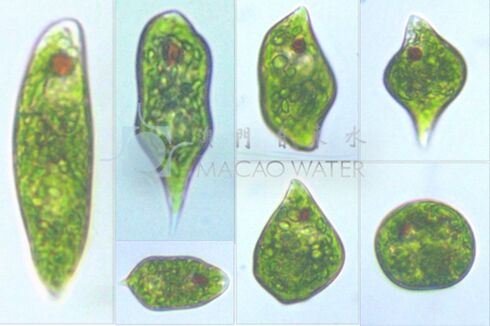「Euglenaria」修訂間的差異
| (未顯示同一使用者於中間所作的 1 次修訂) | |||
| 第1行: | 第1行: | ||
[[文件:Euglenaria.jpg|無框| | [[文件:Euglenaria.jpg|無框|490x490px|link=https://algae.macaowater.com/images/7/75/Euglenaria.jpg]] | ||
''' | '''裸藻門 Euglenophyta''' | ||
'''裸藻綱 Euglenophyceae''' | |||
'''裸藻目 Euglenida''' | '''裸藻目 Euglenida''' | ||
| 第9行: | 第10行: | ||
'''裸藻科 Euglenidae''' | '''裸藻科 Euglenidae''' | ||
''' | '''眼裸藻屬 Euglenaria Karnkowska, Linton & Kwiatowski, 2010''' | ||
'''描述:'''The cells are small (24–38μm × 9–18μm), unusually motile, wide and spindle-shaped, yet narrowed in the middle; in broad terms each cell resembles an hourglass and it is slightly asymmetrical. The anterior is rounded and a bit smaller than the posterior, which tapers off abruptly into a sharp, hyaline tailpiece (5–10 μm long). The single emergent flagellum is long (1.5–2 times the body length). There are usually three relatively large chloroplasts per cell, which are parietal and plate-like, with uneven, incised outlines. Each chloroplast contains a pyrenoid, which is accompanied by two paramylon caps. The periplast is striated in a distinct spiral pattern. There are numerous small paramylon grains, which have various shapes (oval, rod-shaped, ring-shaped) and most are concentrated at the front of the cell (Figs 4, 5), where chloroplasts are absent. The single emergent flagellum is long (1.5–2 times the body length). The stigma is relatively large. Mucocysts are absent. | '''描述:'''The cells are small (24–38μm × 9–18μm), unusually motile, wide and spindle-shaped, yet narrowed in the middle; in broad terms each cell resembles an hourglass and it is slightly asymmetrical. The anterior is rounded and a bit smaller than the posterior, which tapers off abruptly into a sharp, hyaline tailpiece (5–10 μm long). The single emergent flagellum is long (1.5–2 times the body length). There are usually three relatively large chloroplasts per cell, which are parietal and plate-like, with uneven, incised outlines. Each chloroplast contains a pyrenoid, which is accompanied by two paramylon caps. The periplast is striated in a distinct spiral pattern. There are numerous small paramylon grains, which have various shapes (oval, rod-shaped, ring-shaped) and most are concentrated at the front of the cell (Figs 4, 5), where chloroplasts are absent. The single emergent flagellum is long (1.5–2 times the body length). The stigma is relatively large. Mucocysts are absent. | ||
於 2024年5月29日 (三) 03:49 的最新修訂
裸藻門 Euglenophyta
裸藻綱 Euglenophyceae
裸藻目 Euglenida
裸藻科 Euglenidae
眼裸藻屬 Euglenaria Karnkowska, Linton & Kwiatowski, 2010
描述:The cells are small (24–38μm × 9–18μm), unusually motile, wide and spindle-shaped, yet narrowed in the middle; in broad terms each cell resembles an hourglass and it is slightly asymmetrical. The anterior is rounded and a bit smaller than the posterior, which tapers off abruptly into a sharp, hyaline tailpiece (5–10 μm long). The single emergent flagellum is long (1.5–2 times the body length). There are usually three relatively large chloroplasts per cell, which are parietal and plate-like, with uneven, incised outlines. Each chloroplast contains a pyrenoid, which is accompanied by two paramylon caps. The periplast is striated in a distinct spiral pattern. There are numerous small paramylon grains, which have various shapes (oval, rod-shaped, ring-shaped) and most are concentrated at the front of the cell (Figs 4, 5), where chloroplasts are absent. The single emergent flagellum is long (1.5–2 times the body length). The stigma is relatively large. Mucocysts are absent.
